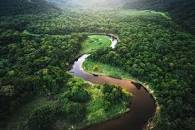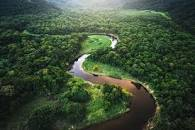
The Amazon rainforest, often referred to as the “Amazon jungle,” is the world’s largest tropical rainforest and spans across several South American countries, primarily Brazil, but also parts of Peru, Colombia, and several other countries. It covers an area of approximately 5.5 million square kilometers, which is roughly the size of the contiguous United States.
Spanning multiple countries in South America and showcasing unparalleled biodiversity, the Amazon Rainforest is not only the largest forest in the world but also a vital component of the global ecosystem. In this article, we will discuss about Key features and facts about the Amazon rainforest.
- Key features and facts about the Amazon rainforest
- Biodiversity: The biodiversity of the Amazon Rainforest is unparalleled. It is home to an estimated 10% of all known species on the planet. Plants, insects, birds, mammals, reptiles, and amphibians are all included. Many of the species found here are endemic, meaning they can only be found here. The incredible diversity can be attributed to the rainforest’s diverse ecosystems, which range from lowland forests to montane forests and riverine habitats.
- Climate Regulation: The Amazon rainforest is critical to climate regulation on Earth. It serves as a carbon sink, absorbing CO2 from the atmosphere and releasing oxygen via photosynthesis. Deforestation and rainforest degradation can release stored carbon into the atmosphere, contributing to climate change.
- Water Cycle: The rainforest is often referred to as the “lungs of the Earth” due to its ability to produce oxygen. It also has an impact on the global water cycle by releasing large amounts of water vapor into the atmosphere via a process known as transpiration. This moisture influences regional and global weather patterns.
- Indigenous Peoples: The Amazon region is home to numerous indigenous communities with rich cultures and deep connections to the land. These communities have historically relied on the rainforest’s resources for their livelihoods and spiritual practices.
- Threats: The Amazon rainforest faces various threats, including deforestation for agriculture, logging, mining, and infrastructure development. These activities can lead to habitat loss, biodiversity decline, and disruption of the rainforest’s critical ecological functions.
- Conservation Efforts: Efforts to protect and conserve the Amazon rainforest include establishing protected areas, supporting sustainable land-use practices, and advocating for indigenous land rights. International organizations, governments, NGOs, and indigenous groups collaborate to address the challenges facing the rainforest.
- Biodiversity Hotspot: The Amazon rainforest is considered one of the planet’s biodiversity hotspots, which are regions with exceptionally high levels of species diversity that are also under significant threat from human activities.
- Guardians of the Carbon Cycle
- The Amazon rainforest plays an important role in the Earth’s carbon cycle. Plants absorb carbon dioxide from the atmosphere and release oxygen through photosynthesis, helping to keep the planet’s inhabitants breathing clean air. The Amazon’s dense vegetation acts as a significant carbon sink, storing carbon within its trees, soil, and plant matter.
- The Hydrological Engine of the Planet
- The Amazon rainforest is more than just a forest; it’s a dynamic hydrological engine that influences weather patterns all over the world. Trees release water vapor into the atmosphere through a process known as transpiration, forming clouds that eventually lead to rainfall. This process not only feeds the rainforest, but it also contributes to weather systems that affect regions far beyond its borders.


